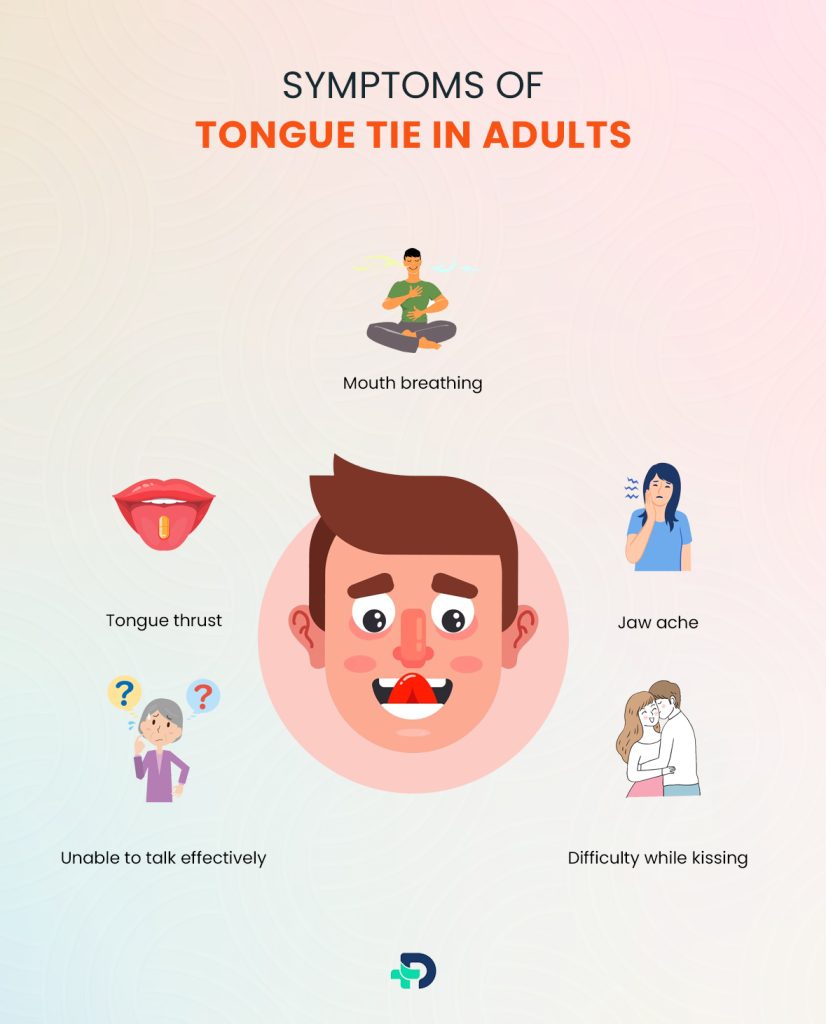Diagnosis & Management Of Tongue Tie In Adults

- Tongue Problems
- 12 Oct 2023
Overview
Tongue Tie
Ankyloglossia, is also known as tongue-tie. It is a condition that limits the tongue’s range of motion by birth. Tongue-tie develops when the bottom of the tip of the tongue is attached to the floor of the oral cavity by an unusually small, thick, or stiff band of tissue that may interfere while breastfeeding. An individual with tongue-tie may find it difficult to push out their tongue. Tongue-tie can also impair children’s ability to swallow, talk, and consume food.

The tongue tie may not be a concern always. Some situations might just need a quick surgical fix. 1 Overview | Researched based study from Mayo Clinic
What is a tongue tie?
- Tongue-tie is a congenital condition where a person’s tongue is permanently attached to the bottom of their oral cavity.
- A shorter-than-usual lingual frenulum, which connects your tongue to the bottom of your mouth, causes this.
- Your tongue might move more slowly if your frenulum is short.
- Ankyloglossia can affect adults as well, however young kids and newborns are the most generally affected.
- It causes issues with speech and difficulty in nursing. 4 Overview | Researched based study from Cleveland Clinic
Symptoms

Symptoms of Tongue Tie in Adults
The severity of tongue-tie symptoms may differ in every individual. Ankyloglossia is mild enough that daily activities are not affected by the symptoms. Adult tongue ties can cause:
- Mouth breathing
- Unable to talk effectively
- Difficulty while kissing
- Jaw ache
- Tongue thrust 4 Symptoms | Researched based study from Cleveland Clinic
Diagnosis
How to Diagnose Tongue Tie?
The majority of variations in the tongue’s bottom and how it adheres to the mouth’s floor are not alarming. A technique for identifying the type of tongue-tie is the Coryllos ankyloglossia grading scale.
- Type I: The tongue’s tip is fastened to the ridge below the lower teeth by the thin, elastic frenulum.
- Type II: The tongue is attached 2 to 4 millimeters above the tip to the floor of the oral cavity along the ridge below the lower teeth, and the frenulum is fine and elastic.
- Type III: The tongue is anchored from the center of the underside to the floor of the oral cavity by a strong, tight frenulum. 5 Diagnosis | Researched based study from Johns Hopkins Medicine
How can I check my tongue tie at home?
Parents can detect the many tongue tie signs. Among them are:
- Frequently severe drooling, trouble swallowing, or “tongue-tied” speech, perhaps accompanied by dyslexia or language problems
- Even when children have teeth that are up to grade 3 (5 to 6 years old), speech sounds and language delays occur.
- Neck spasms and electric shock-like symptoms that resemble migraines.
- Frequently painful tongue-twisting or lip-opening reflexes that disrupt sleep, eating, and communicating
- Narrow lip appearance. 6 Diagnosis | Researched based study from National Institutes of Health
Treatment
Treatment for Tongue Tie in Adults
Treatment may be necessary if tongue-tie is causing discomfort or if it is preventing the patient from eating, speaking, or maintaining good oral hygiene.
Frenotomy:
- A frenotomy, also known as a frenulotomy, is a surgical procedure that unlocks the frenulum, allowing the tongue to move more easily.
- Most infants can eat right away after the treatment. 5 Treatment | Researched based study from Johns Hopkins Medicine
Frenuloplasty:
- It is a kind of plastic surgery of the frenulum, used for more complicated tongue-tie situations or for revision surgeries.
- The rehabilitation procedure may include exercises for the tongue and speech therapy.
- There are dangers associated with frenulum treatments, including significant bleeding, infection, damage to the salivary ducts, and deteriorating respiration, even though the procedures are generally safe.
- The likelihood of a kid having a frenectomy surgery contraindicated should be determined. 5 Treatment | Researched based study from Johns Hopkins Medicine
Disadvantages
Disadvantages of Clipping Tongue Tie in Adults
Having a frenectomy has various drawbacks despite its efficacy and minimal risk, which include: 7 Disadvantages | Researched based study from National Institutes of Health
Unrestrained Speaking:
- Those with tongue tie may experience difficulty managing their speech after a frenectomy. Even if the frenectomy does not result in uncontrollable speech, you can lose some of the long-established speech patterns.
- These incorporate subtly altering speech and articulating particular sounds to make up for tongue-tie.
- Because of this, some medical professionals advise those who have had frenectomy surgery to undergo therapy to strengthen and reorganize the muscles surrounding their tongues, enabling them to utilize their tongues more efficiently.
Food Swallowing Difficulties:
- For a few weeks following the procedure, you can suffer pain when swallowing meals and beverages.
- Before having the surgery, you should speak with your doctor if you have any concerns regarding your capacity to swallow.
Discomfort and pain:
- Even though the process itself is typically painless, you could have pain when recovering after surgery.
- When eating or swallowing, some patients experience a little discomfort, especially in the initial days following surgery.
Complications Risk:
- There is always a possibility of problems during and following your tongue-tie therapy, including bleeding and infection, just like with most surgical operations.
Consistency in the outcome:
- The results of frenectomies depend on a number of variables.
- This pertains to the tongue’s size, the degree of its tongue tie, and its placement in relation to other oral structures.
- A frenectomy might not always function as it ought to. Adults who have undergone surgery may experience a detrimental impact on their ability to speak and swallow as a result. 7 Disadvantages | Researched based study from National Institutes of Health
Benefits
Benefits of Tongue Tie Release in Adults
Speech and Articulation Improvements:
- Adults could see an almost immediate improvement in their speech and articulation by removing the constriction in the frenulum.
Better Dental Health and Oral Hygiene:
- Patients may find it simpler to properly clean their teeth without overlooking any difficult-to-reach spots by removing the constriction in the frenulum.
Improved Breathing and Sleep Quality:
- By removing the constriction in the frenulum, tongue tie release surgery can aid with these problems.
- This could facilitate breathing and lessen signs of sleep apnea or snoring.
Improves Digestion:
- Digestion is significantly improved in patients who have this treatment because they are able to move food throughout more effectively and create more saliva as needed. 3 Benefits | Researched based study from North American Association of Facial Orthotropics
FAQs
Frequently Asked Questions About Tongue Tie
Q. Is tongue-tie a major problem?
If tongue-tie is not corrected, moderate to severe forms can lead to a variety of issues, such as:
- Feeding issues can result in inadequate growth or malnutrition.
- Breastfeeding is often more difficult than bottle feeding once a baby develops a tongue tie.
- Speech disorders can be problematic in the classroom.
- Eating some meals might be difficult. 4 FAQs | Researched based study from Cleveland Clinic
Q. How do you fix a tongue-tie naturally?
- Some children’s symptoms, or all of them, disappear with time.
- The frenulum normally recedes between 6 months to 6 years of age. If the tongue tie was only slight, this could be the solution.
- Your youngster could learn solutions to the issue over time.
- If your child develops class 3 or class 4 tongue tie, symptoms might not go away as quickly. 2 FAQs | Researched based study from Cedars-Sinai
Q. Does tongue-tie improve with age?
- Tongue-tie sufferers may get better over time without any therapy.
- But the majority of the time, tongue tie surgery is required.
- Your child’s lingual frenum will be clipped during this quick treatment, releasing the tongue from any restrictions. 4 FAQs | Researched based study from Cleveland Clinic
Q. Does tongue tie affect face shape?
- A tongue tie restricts the tongue’s range of motion, which might have a variety of negative effects on oral health, such as problems with facial and speech development, tooth and jaw alignment, and others.
- The reduced range of motion of the tongue may have affected the contour of the face in those who experienced living with a tongue tie past infancy. 3 FAQs | Researched based study from North American Association of Facial Orthotropics
Q. Is tongue tie reversible?
- Sometimes as kids become older, they figure out how to deal with tongue-tie. However, it is important to address ankyloglossia as soon as difficulties arise because some symptoms get worse with advancing age. 4 FAQs | Researched based study from Cleveland Clinic
Q. Can a dentist cut a tongue tie?
- A frenectomy, a straightforward surgery performed by a dentist, can treat tongue tie.
- A dentist or surgeon will perform a frenectomy to alleviate the tension in the frenectomy.
- Local anesthesia and a laser are frequently used by dentists to complete the treatment fast and painlessly. 6 FAQs | Researched based study from National Institutes of Health
Conclusion
Tongue Tie in Adults: Consult your Doctor
Tongue tie raises the possibility of speech or eating difficulties. Many medical and dental professionals are involved in the treatment of ankyloglossia. Primary care physicians, pediatric specialists, otolaryngologists, nurse practitioners, speech therapists, and dentists may all deal with ankyloglossia. 6 Conclusion | Researched based study from National Institutes of Health
Any feedback on this article?
 This Articles content was accurate
This Articles content was accurate Very Informative Article
Very Informative Article I have a question or a comment
I have a question or a comment
 This article contains inaccurate content
This article contains inaccurate content This article was not helpful
This article was not helpful I have a question or a comment
I have a question or a comment
We appreciate your helpful feedback!
Checkout our social pages
References
-
Mayo Clinic
Overview
-
Cedars-Sinai
FAQs
-
North American Association of Facial Orthotropics
Benefits | FAQs
-
Cleveland Clinic
Overview | Symptoms | FAQs
-
Johns Hopkins Medicine
Diagnosis | Treatment
-
National Institutes of Health
Diagnosis | FAQs | Conclusion
-
National Institutes of Health
Disadvantages




































